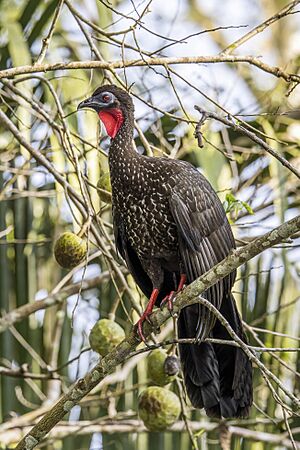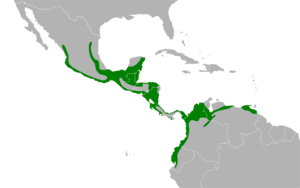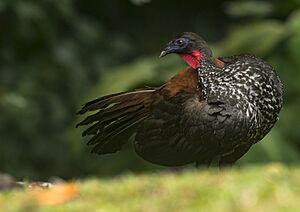Crested guan facts for kids
Quick facts for kids Crested guan |
|
|---|---|
 |
|
| P. p. purpurascens Belize |
|
| Conservation status | |
| Scientific classification | |
| Genus: |
Penelope
|
| Species: |
purpurascens
|
| Subspecies | |
|
see text |
|
 |
|
The crested guan (Penelope purpurascens) is a large bird found in Central America and parts of South America. It is a Near Threatened species, meaning its population is getting smaller. This bird belongs to an ancient group of birds called Cracidae, which are related to Australasian birds known as megapodes.
Contents
What is a Crested Guan?
The crested guan is a type of bird that looks a bit like a turkey. It lives in forests from central Mexico all the way down through Central America to countries like Colombia, Ecuador, Peru, and Venezuela.
Different Types of Crested Guans
Just like there are different breeds of dogs, there are different types of crested guans called subspecies. The crested guan has three main subspecies:
- P. p. purpurascens
- P. p. aequatorialis
- P. p. brunnescens
These subspecies are slightly different in size or color, depending on where they live.
Appearance of the Crested Guan
The crested guan is a fairly large bird. It can be about 76 to 91.5 centimeters (30 to 36 inches) long. It weighs around 1.6 to 2.4 kilograms (3.5 to 5.3 pounds).
It has a small head, strong long legs, and a long, wide tail. Both male and female crested guans look very similar. Their feathers are mostly a dark olive-brown color. They might have a slight green or purple shine. Their belly is a chestnut color, and the feathers on their chest have white edges.
A cool feature is the small red, loose skin hanging from their throat. This is called a wattle. They also have red eyes, a black beak, and red legs and feet. Young guans look a lot like the adults but have a more mottled pattern.
Where Crested Guans Live
Crested guans live in many different types of forests. These include tropical and subtropical forests that stay green all year. They also live in forests where trees lose their leaves, misty cloudforests, and mountain forests. They prefer places that are semi-humid to humid.
You can find them from sea level up to high elevations in the mountains. For example, in northern Central America, they live up to 2,500 meters (8,200 feet) high. In other areas like Peru, they are found at lower elevations, around 800 meters (2,600 feet).
Crested Guan Behavior
Crested guans stay in the same area all year round. They do not migrate.
What They Eat
Crested guans mostly eat fruit. They often find fruit high up in the trees. They can move quickly and gracefully from branch to branch by jumping or taking short flights. They also eat fruit that has fallen to the ground.
Interestingly, one study found that they also eat young leaves and even insects. This shows they have a varied diet!
How They Raise Their Young
Crested guans are monogamous, meaning a male and female pair up. In Costa Rica, their breeding season is from March to June. They build a large nest made of twigs and leaves high up in a tree.
They usually lay two eggs. In captivity, the eggs hatch after about 26 days. Scientists are still learning about how long it takes for the young birds to grow and how the parents care for them in the wild.
Sounds They Make
Crested guans make several interesting sounds:
- Their dawn song sounds like a powerful "steam-whistle" call, ending in a low growl: ku LEEErrr!
- They also make a loud, honking quonk.
- When they are alarmed, they make a series of very loud, honking squawks: quonk, quonk, quonk, rrrrrrrrr.
- Other calls include a loud, far-carrying WOK!-WOK!-WOK! and a low, nasal grunt.
- During the breeding season, males will fly in a special way at dawn. They make a drumming or whirring sound with their wings.
Conservation Status
The IUCN (International Union for Conservation of Nature) first listed the crested guan as "Least Concern" in 2004. However, in 2021, its status was changed to "Near Threatened." This means that while it's not in immediate danger, its population is decreasing.
There are an estimated 50,000 to 500,000 adult crested guans left. The main reasons their numbers are going down are:
- Habitat loss: Their forest homes are being cut down. This is often to make space for farms and cattle pastures.
- Hunting: The birds are also hunted a lot, especially in Central America.
Mexican authorities consider the crested guan a "Threatened" species. While they are uncommon in some areas, they are fairly common in protected areas in Costa Rica.



